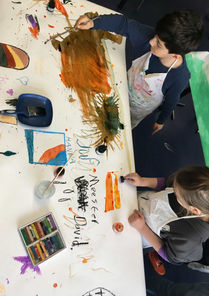- - - - - - - - - - - - - - - - - - - - - - - - - - - - - - - - - - -
Workshops with children from 6 to 11 years old, 2023-24

I like to let ideas for the workshops arise organically from the children and their living environment. At the same time, I incorporate materials, techniques, ideas, and themes from my own work. I also draw inspiration from the ideas and techniques that arise during the workshops, integrating them into my own practice.
Recurring elements throughout the programs include games that explore themes of impermanence, coincidence, expressiveness, and spontaneity in relation to the children’s immediate surroundings. I also encourage working on a large scale and collaborating as a group, emphasizing collective engagement. This approach prioritizes action, play, and communication during the creative process, rather than reflecting on the finished product. It’s about fostering dialogue and discovery in the moment of making — learning from one another through shared experiences and participation when the energy is still high, and there’s a desire to express and share thoughts while creating.
As a teacher or guide, I sometimes adopt a posture of ignorance and curiosity and embrace moments of uncertainty to minimize the teacher-student power dynamic. I’ve experienced that when you, as a teacher, collaborate with the students, different types of conversations arise compared to when you only give them instructions or assignments. This approach creates space for the children to collaborate with me, think independently, and in return teach me something in the process.
I also strive to avoid simply complimenting the quality of a drawing, as I believe it’s important for participants to think and draw for themselves as a means of exploration and communication. Each participant has their own pace and path of development, so I work to build their confidence by asking questions like, "How did you create this part?" or "What did you discover while working on this?" Every child is unique and sees the world differently. Drawing offers an intuitive way for them to share and communicate these personal perspectives.



This is a dialogue (from the book The Brothers Karamazov by Dostoyevsky) between Alyosha, a philosophical young man, and Kolya, a thirteen-year-old who admires Alyosha and wants to be taken seriously by him.
This excerpt resonates with me in relation to current situations where the expectations and uncertainties of children towards adults, and vice versa, still exist.
You are thirteen?’ asked Alyosha.
No, fourteen – that is, I shall be fourteen very soon, in a fortnight. I’ll confess one weakness of mine, Karamazov, just so you, since it’s our first meeting, may understand my character at once. I hate being asked my age, more than that… and in fact… there’s a libellous story going about me, that last week I played robbers with the preparatory boys. It’s a fact that I did play with them, but it’s a perfect libel to say I did it for my own amusement. I have reasons for believing that you’ve heard the story; but I wasn’t playing for my own amusement, it was for the sake of the children, because they couldn’t think of anything to do by themselves. But they’ve always got some silly tale. This is an awful town for gossip, I can tell you.
But what if you had been playing for your own amusement, what’s the harm?
Come, I say, for my own amusement! You don’t play horses, do you?
But you must look at it like this,’ said Alyosha, smiling. ‘Grown-up people go to the theatre and there the adventures of all sorts of heroes are represented – sometimes there are robbers and battles, too – and isn’t that just the same thing, in a different form, of course? And young people’s games of soldiers or robbers in their playtime are also art in its first stage. You know, they spring from the growing artistic instincts of the young. And sometimes these games are much better than performances in the theatre; the only difference is that people go there to look at the actors, while in these games the young people are the actors themselves. But that’s only natural.



























